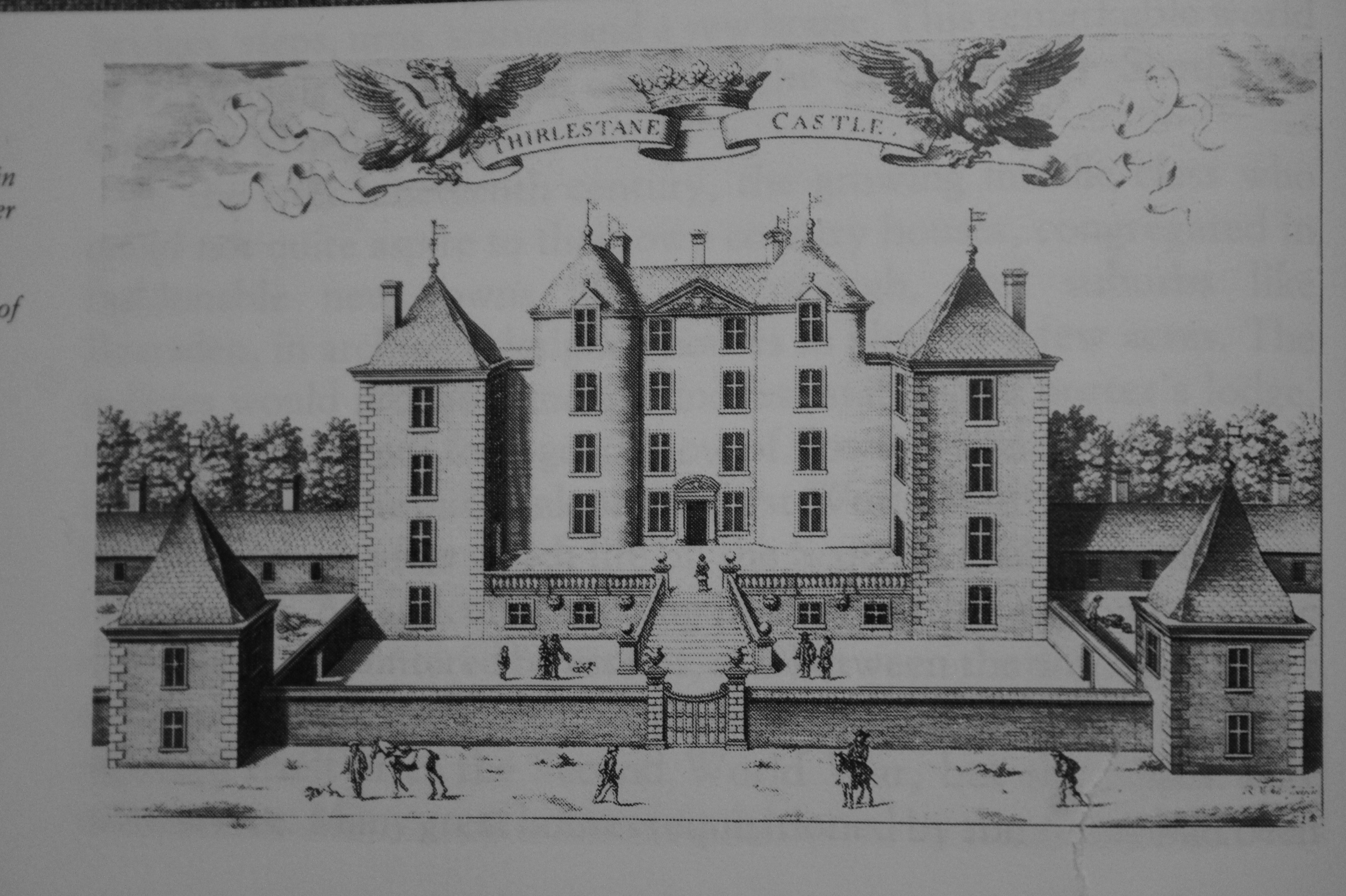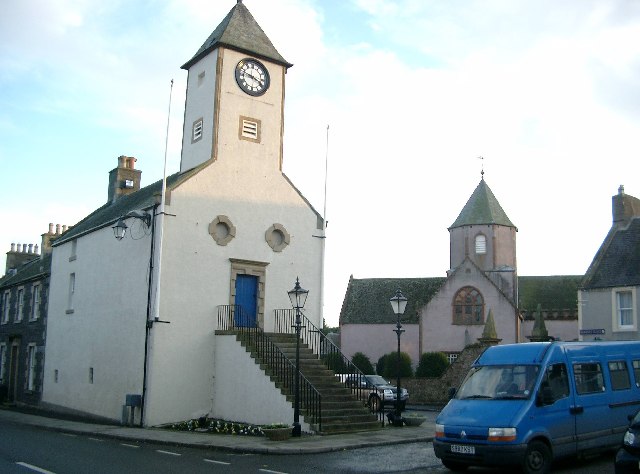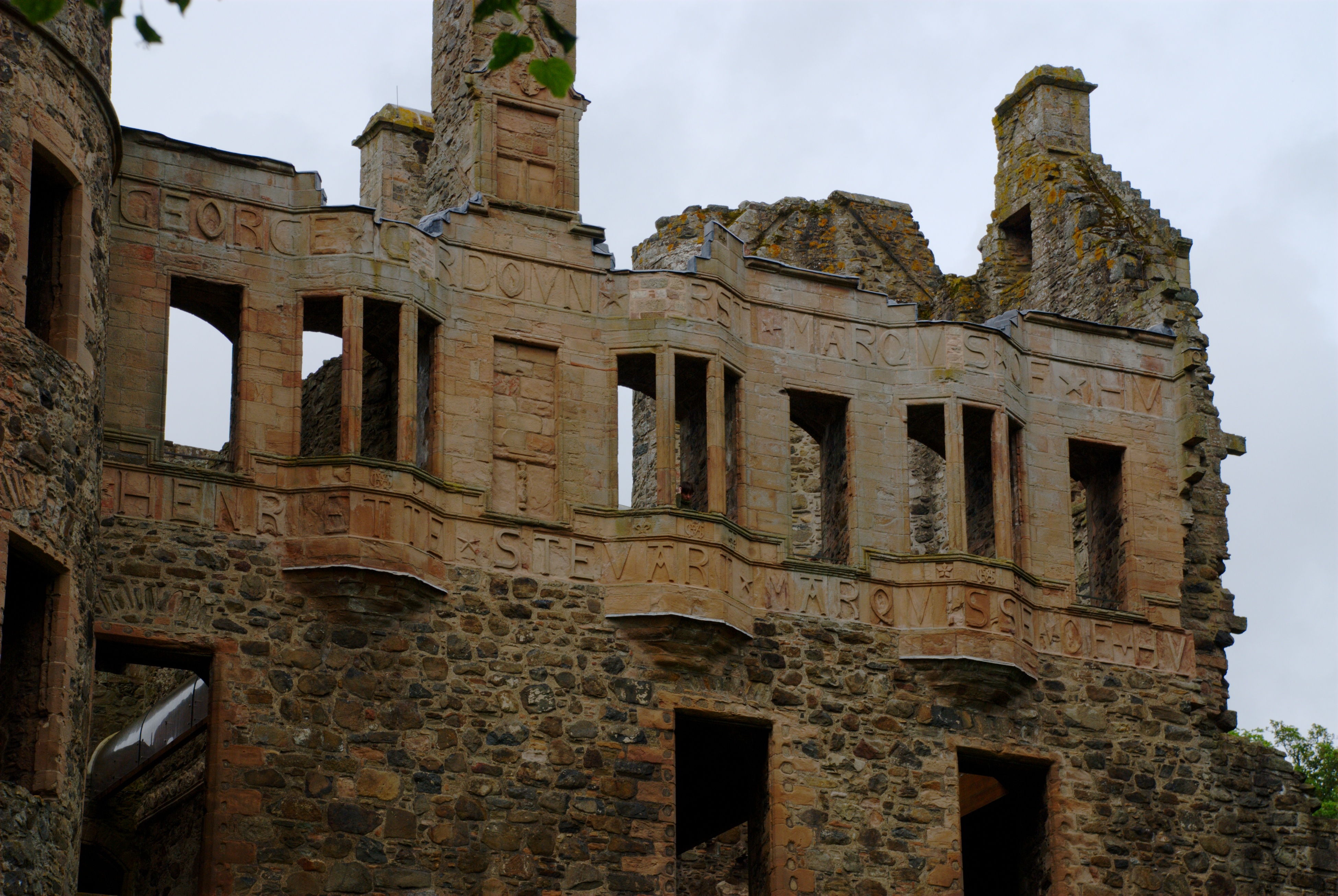|
Patrick Murray (courtier)
Patrick Murray was a Scottish courtier. He was a son of Andrew Murray of Balvaird and Janet Graham, a daughter of William Graham, 2nd Earl of Montrose. His brother was David Murray, 1st Viscount of Stormont He was a gentleman of chamber to James VI of Scotland from 1591 to 1596. He acquired the lands of Binn and Geanis or Ganys near Inverness. In October 1593, James VI went to stay for a few days at Thirlestane Castle at Lauder, the home of the Chancellor of Scotland, John Maitland. The English ambassador heard that he had gone from there to Perth, to meet the excommunicated earls. Roger Aston told him this was not true, and it seems that Bowes had been misled by Patrick Murray. Bowes wrote that "Paty Murray" was the agent of the excommunicated earls. He was called to serve as a gentleman of the king's chamber in November. He brought the king's instructions to the Presbytery of Aberdeen in January 1597. In May 1597 he was sent to the north of Scotland by James VI to settle v ... [...More Info...] [...Related Items...] OR: [Wikipedia] [Google] [Baidu] |
Balvaird Castle
Balvaird Castle in Perthshire is a traditional late medieval Scottish tower house. It is located in the Ochil Hills, around south of Abernethy. The name Balvaird is from ''Baile a' Bhàird'', 'Township of the Bard' in Gaelic. Balvaird Castle is a scheduled monument, and is in the care of Historic Environment Scotland. The spelling of its name has many variations, including Balverd, Balverde, Balward, Balwaird and Baleward. Origins Balvaird was built around the year 1495 for Sir Andrew Murray, a younger son of the family of Murray of Tullibardine. He acquired the lands of Balvaird through marriage to the heiress Margaret Barclay, a member of a wealthy family and daughter of James Barclay of Kippo. It is likely that Balvaird Castle was built on the site of an earlier Barclay family castle. Substantial remnants of earthwork fortifications around the Castle may survive from earlier defences. Balvaird is first mentioned in the written historical record in 1498 as 'the place of Balwar ... [...More Info...] [...Related Items...] OR: [Wikipedia] [Google] [Baidu] |
William Graham, 2nd Earl Of Montrose
William Graham, 2nd Earl of Montrose (1492 – 24 May 1571) was a Scottish nobleman and statesman, who successfully steered a moderate course through the treacherous waters of mid-16th century Scottish politics. Origins Graham was the eldest son and heir of William Graham, 1st Earl of Montrose by Annabel, a daughter of John Drummond, 1st Lord Drummond. The Grahams were a long-established family of Norman origin, who first rose to prominence in the reign of David I. Career in the reign of James V Montrose succeeded to the earldom as a minor, following the death of his father at the Battle of Flodden. In 1525, he was one of a number of lords selected to attend personally on the King and in June 1535 he was appointed an ambassador to France in connection with the King's marriage. On 29 August 1536, he was named as one of the Commission of Regency during the King's absence in France until the King returned in 1537 with Madeleine of Valois.Sir John Balfour Paul, ''The Scots Peerag ... [...More Info...] [...Related Items...] OR: [Wikipedia] [Google] [Baidu] |
David Murray, 1st Viscount Of Stormont
David Murray, 1st Viscount of Stormont (died 27 August 1631) was a Scottish courtier, comptroller of Scotland and captain of the king's guard, known as Sir David Murray of Gospertie, then Lord Scone, and afterwards Viscount Stormont. He is known for his zeal in carrying out the ecclesiastical policy of James VI and I, in which he was effective if crude. Life He was the second son of Sir Andrew Murray of Arngask and Balvaird, brother of William Murray of Tullibardine, by his second wife, Janet Graham, fourth daughter of William Graham, 2nd Earl of Montrose. He was brought up at the court of James VI, who made him his cupbearer in 1580, and master of the horse in 1583. On 12 December 1588 he presented a complaint against the inhabitants of Auchtermuchty, Fife, who, when he went to take possession of the lands of Auchtermuchty, attacked him and the gentlemen of his company, wounding him in various parts of the body, and cutting off one of the fingers of his right hand. At court h ... [...More Info...] [...Related Items...] OR: [Wikipedia] [Google] [Baidu] |
James VI Of Scotland
James VI and I (James Charles Stuart; 19 June 1566 – 27 March 1625) was King of Scotland as James VI from 24 July 1567 and King of England and Ireland as James I from the union of the Scottish and English crowns on 24 March 1603 until his death in 1625. The kingdoms of Scotland and England were individual sovereign states, with their own parliaments, judiciaries, and laws, though both were ruled by James in personal union. James was the son of Mary, Queen of Scots, and a great-great-grandson of Henry VII, King of England and Lord of Ireland, and thus a potential successor to all three thrones. He succeeded to the Scottish throne at the age of thirteen months, after his mother was compelled to abdicate in his favour. Four different regents governed during his minority, which ended officially in 1578, though he did not gain full control of his government until 1583. In 1603, he succeeded Elizabeth I, the last Tudor monarch of England and Ireland, who died childless. He c ... [...More Info...] [...Related Items...] OR: [Wikipedia] [Google] [Baidu] |
Thirlestane Castle
Thirlestane Castle is a castle set in extensive parklands near Lauder in the Borders of Scotland. The site is aptly named Castle Hill, as it stands upon raised ground. However, the raised land is within Lauderdale, the valley of the Leader Water. The land has been in the ownership of the Maitland family since 1587, and Thirlestane served as the seat of the Earls of Lauderdale. The castle was substantially extended in the 1670s by the first and only Duke of Lauderdale. Further additions were made in the 19th century. The castle is now cared for by a charitable trust, and is open to the public. History of the castle Before the 13th century, a large fort or castle was built on Castle Hill near the Leader Water. It was the site of the ancient church of Lauder, where in 1482, James III's favourites, including the architect Robert Cochrane, were dragged by envious nobles led by Archibald Douglas, 5th Earl of Angus and hanged from the (earlier) Lauder Bridge. The sites of the ancient ... [...More Info...] [...Related Items...] OR: [Wikipedia] [Google] [Baidu] |
Lauder
The former Royal Burgh of Lauder (, gd, Labhdar) is a town in the Scottish Borders in the Shires of Scotland, historic county of Berwickshire. On the Southern Upland Way, the burgh lies southeast of Edinburgh, on the western edge of the Lammermuir Hills. Etymology Although Lauder sits in the valley of Leader Water, William J. Watson, Watson notes that the names Lauder and Leader appear to be unconnected. In the earliest sources Lauder appears as ''Lawedder'' and ''Loweder''. The name may be derived from the Common Brittonic, Brittonic ''lǭwadr'', meaning "washing or bathing place" (Breton language, Breton ''laouer''). Or else, Lauder may be named from a word related to Middle Welsh ''llawedrawr'', "a heap of ruins". Medieval history Below Lauder are the lands of Kedslie which were bounded on the west by a road called "Malcolm's rode", and it is thought this formed part of the Roman road known as Dere Street, which passed through Lauder. Hardie suggests that it had been rec ... [...More Info...] [...Related Items...] OR: [Wikipedia] [Google] [Baidu] |
Chancellor Of Scotland
The Lord Chancellor of Scotland, formally the Lord High Chancellor, was a Great Officer of State in the Kingdom of Scotland. Holders of the office are known from 1123 onwards, but its duties were occasionally performed by an official of lower status with the title of Keeper of the Great Seal. From the 15th century, the Chancellor was normally a Bishop or a Peer. At the Union, the Lord Keeper of the Great Seal of England became the first Lord High Chancellor of Great Britain, but the Earl of Seafield continued as Lord Chancellor of Scotland until 1708. He was re-appointed in 1713 and sat as an Extraordinary Lord of Session in that capacity until his death in 1730. List of Lords Chancellors of Scotland David I * 1124-1126: John Capellanus * 1126-1143: Herbert of Selkirk * bef.1143-1145: Edward, Bishop of Aberdeen * c.1147–c.1150: William Cumin * bef.1150-1153: Walter, possibly Walter fitz Alan Malcolm IV * 1153–1165: Enguerrand, Bishop of Glasgow William I * 1165-1171: ... [...More Info...] [...Related Items...] OR: [Wikipedia] [Google] [Baidu] |
John Maitland, 1st Lord Maitland Of Thirlestane
John Maitland, 1st Lord Maitland of Thirlestane (1537 – 3 October 1595), of Lethington, Knight (1581), was Lord Chancellor of Scotland. Life He was the second son of Sir Richard Maitland of Thirlestane, Berwickshire, and Lethington, Haddingtonshire, who settled the lands of Thirlestane upon him, and thereafter sent him abroad for his education. Through the influence of his brother, William Maitland, upon John Maitland's return, he received the offer of the position of Commendator of Kelso Abbey, which he shortly afterwards exchanged with Francis Stewart, later Earl of Bothwell, for the Priory of Coldingham. This transaction was ratified by Mary, Queen of Scots on 20 April 1567. Upon the death of his father, he was appointed Keeper of the Privy Seal of Scotland, on 20 April 1567. He also supported Regent Moray and sat in his parliaments in December 1567 and August 1568. On 2 June 1568, he was created a Senator of the College of Justice as an Ordinary Lord on the spiritual ... [...More Info...] [...Related Items...] OR: [Wikipedia] [Google] [Baidu] |
Roger Aston
Sir Roger Aston (died 23 May 1612) of Cranford, Middlesex, was an English courtier and favourite of James VI of Scotland. Biography Aston was the illegitimate son of Thomas Aston (died 1553), Thomas Aston (died 1553). Scottish sources spell his name variously as "Aschetone", "Aschetoun", or "Aschingtoun". After serving the Regent Lennox, Earl of Lennox, Henry Stuart, Lord Darnley, Lord Darnley, and Mary, Queen of Scots, Aston was made a Gentleman of the Bedchamber to James VI of Scotland in 1578. In England, he was Master of the Great Wardrobe to King James I in England. He held both positions until his death. From 1595 he was keeper of Linlithgow Palace, and one of his daughters was born at the palace in October 1595. At the Scottish court In May 1580 twenty five gentlemen were appointed as "pensioners to attend the King's Majesty at all times on his riding and passing to the fields". The riding entourage included Aston with, James Stewart, Earl of Arran, Captain James Stewa ... [...More Info...] [...Related Items...] OR: [Wikipedia] [Google] [Baidu] |
Annie Cameron
Annie Isabella Cameron (1897-1973) was a Scottish historian. Biography She was the daughter of Mary Sinclair, and James Cameron, a Glasgow engineer. She studied history at the University of Glasgow and the University of St Andrews. She wrote a doctoral thesis on Bishop Kennedy of St Andrews. She worked at the Scottish Record Office and in 1938 married George Dunlop, proprietor of the ''Kilmarnock Standard''. She died in 1973. Marcus Merriman, a historian of the Rough Wooing acknowledged Annie Cameron, Marguerite Wood, and Gladys Dickinson for their work publishing 16th-century primary sources. He praised Cameron for her "stunning" edition of the Scottish correspondence of Mary of Guise Mary of Guise (french: Marie de Guise; 22 November 1515 – 11 June 1560), also called Mary of Lorraine, was a French noblewoman of the House of Guise, a cadet branch of the House of Lorraine and one of the most powerful families in France. She ..., "placing in the hands of the researcher som ... [...More Info...] [...Related Items...] OR: [Wikipedia] [Google] [Baidu] |
Church Of Scotland
The Church of Scotland ( sco, The Kirk o Scotland; gd, Eaglais na h-Alba) is the national church in Scotland. The Church of Scotland was principally shaped by John Knox, in the Scottish Reformation, Reformation of 1560, when it split from the Catholic Church and established itself as a church in the reformed tradition. The church is Calvinist Presbyterian, having no head of faith or leadership group and believing that God invited the church's adherents to worship Jesus. The annual meeting of its general assembly is chaired by the Moderator of the General Assembly of the Church of Scotland. The Church of Scotland celebrates two sacraments, Baptism and the Lord's Supper in Reformed theology, Lord's Supper, as well as five other Rite (Christianity), rites, such as Confirmation and Christian views on marriage, Matrimony. The church adheres to the Bible and the Westminster Confession of Faith, and is a member of the World Communion of Reformed Churches. History Presbyterian tra ... [...More Info...] [...Related Items...] OR: [Wikipedia] [Google] [Baidu] |
Henrietta Stewart
Henrietta Stewart (1573–1642) was a Scottish courtier. She was the influential favourite of the queen of Scotland, Anne of Denmark. Life Henrietta Stewart was the daughter of Esmé Stewart, 1st Duke of Lennox, favourite of James VI of Scotland, and Catherine de Balsac. On 16 June 1581 the king gave Henrietta the right to award the marriage of the Earl of Huntly, which was forfeited to the crown. Their marriage contract was made in 1586, while she was in France, and James VI granted the Duke of Lennox 5000 merks to organise her transport from France. Henrietta, her sister Marie and her brother Ludovic came back to Scotland from France in November 1583 with their mother to see James VI. The two sisters returned in June 1588 and were lodged in Edinburgh at the town's expense. Marriage and masque On 21 July 1588, Henrietta married George Gordon, Earl of Huntly, at Holyroodhouse. Before the wedding the couple were made to declare their (Protestant) faith, without which the minist ... [...More Info...] [...Related Items...] OR: [Wikipedia] [Google] [Baidu] |
.jpg)




.jpg)

